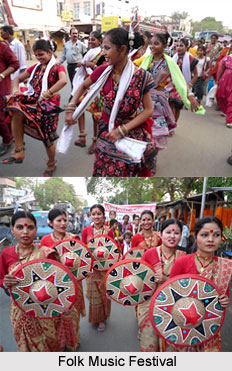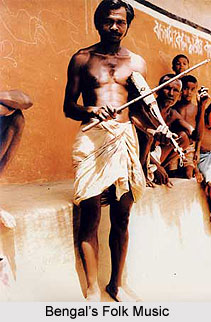 Folk Music, like most other forms of art, is mainly identified by the name of a community, nationality or race belonging to an area. It also refers to singing based on vocal expression that is conditioned by racial habits, formalized as a culture. And folk culture generally dominates a particular area, a geographical region, inhabited by communities who moved from place to place in the past, and ultimately settled for generations. They produced music as a natural condition or as a coincidence in life. Their endeavours in development of ideas and habit of music, traditionally derived from the prehistoric days, remain grafted with belief and reason.
Folk Music, like most other forms of art, is mainly identified by the name of a community, nationality or race belonging to an area. It also refers to singing based on vocal expression that is conditioned by racial habits, formalized as a culture. And folk culture generally dominates a particular area, a geographical region, inhabited by communities who moved from place to place in the past, and ultimately settled for generations. They produced music as a natural condition or as a coincidence in life. Their endeavours in development of ideas and habit of music, traditionally derived from the prehistoric days, remain grafted with belief and reason.
Music, according to some theorists, began with singing, depending on "logogenic process" (word-born) originated from words or on "pathogenic process" (passion-born) based on sound production of man on account of feelings, exclamations, etc. Primitive man sings only when he has something definite to express. Since his singing produces the spontaneous expression of his thought, tune and speech are often mingled in the course of his performance. This is conditioned by his settlement in a locality or a land, the topography of which affects his habit. If he is influenced by the semi-civilized world, the primitive form changes gradually into folk forms. Hence classification of music of primitive and folk types according to particular areas, geographically classified, is consistent with the nature of this enquiry. Actually, in the eastern part of India, different language families have settled in particular geographically demarcated areas. This study, which aims at treating music of India, covers the states of Orissa, West Bengal, Assam, Tripura, Manipur, Mizoram, Nagaland, Meghalaya and Arunachal Pradesh.
| Inhabitants Oriyas and Adivasis | Inhabitants Bengalis and Adivasis | Inhabitants Assamese, Hill people and Adivasis, Bengalis | Inhabitants Bengalis Adivasis Manipuris Hill people |
| 1. The plain lands of Orissan river bed; | 1. The dry and up-and-down regions of West Bengal with Bihar and north-eastern Orissa; the western region of the Bhagirathi river; | 1. The Brahmaputra Valley of Assam with wide and deep areas surrounded by hills around; | 1. The Tripura state with plains, hills and forests contiguous to the east of Bangladesh; |
| 2. The hill tracts and forest regions of the north and northwest;and | 2. The delta area, i.e., the plains of the central southern sector on the east of the river Bhagirathi with forests in the south (Sundarbans) and contiguous plains of Bangladesh in the east; Northern plains of West Bengal extended to hilly regions, the sub-montane | 2. Meghalaya, consisting of Khasi-Jayantia and Mizoram in the south; | 2. Manipur, an inside cup-like table and amongst Naga hills and Burma border hills. |
| 3. Wide coastal areas of Orissa; | 3. Terai known as Boars with adjacent semiliterate region. | 3. Kachhar area, the hilly regions of the south east with plains of Assam area contiguous to Sylhet; Naga hills in the east of Assam; | |
| 4. Arunachal Pradesh in the north and north-east, with mountainous area of the northeast border of India; |
 The multilingual region of eastern India has been ruled by three major Aryan languages - Oriya, Bengali and Assamese - from the very time when languages were born. History suggests that the precursors of these languages settled in this region during or after the Vedic age. Those who lived here from prehistoric period were either integrated in the society or they shifted themselves to some areas where they lived in pockets. Then again, during and after this period, fresh infiltrators who came from outside, i.e., from the eastern countries across the borders found their abode near agricultural lands, forests, river banks, hills and dales and mountain slopes. They all had their own cells or were mixed up with the population already settled. Thus, Indo-Aryan cult predominated in the area.
The multilingual region of eastern India has been ruled by three major Aryan languages - Oriya, Bengali and Assamese - from the very time when languages were born. History suggests that the precursors of these languages settled in this region during or after the Vedic age. Those who lived here from prehistoric period were either integrated in the society or they shifted themselves to some areas where they lived in pockets. Then again, during and after this period, fresh infiltrators who came from outside, i.e., from the eastern countries across the borders found their abode near agricultural lands, forests, river banks, hills and dales and mountain slopes. They all had their own cells or were mixed up with the population already settled. Thus, Indo-Aryan cult predominated in the area.




















